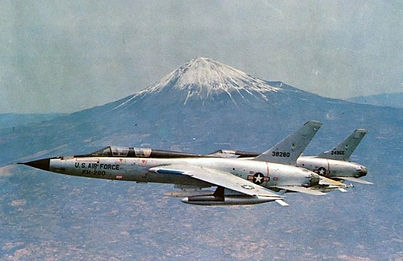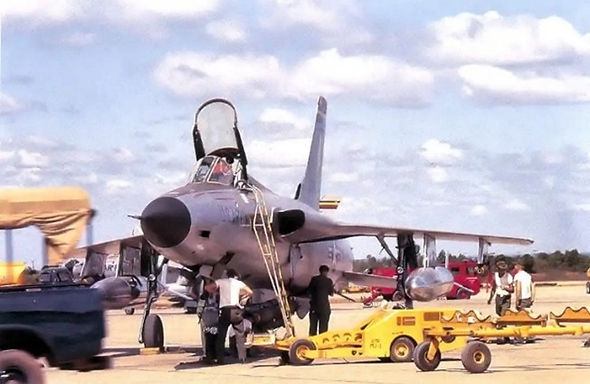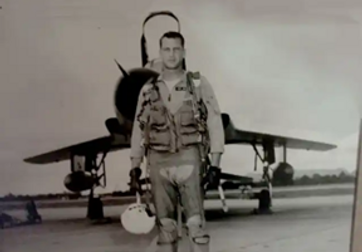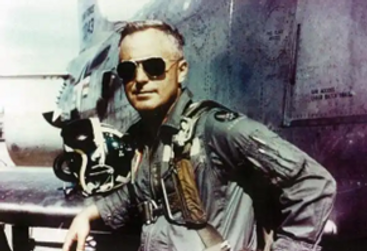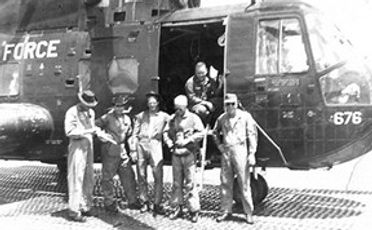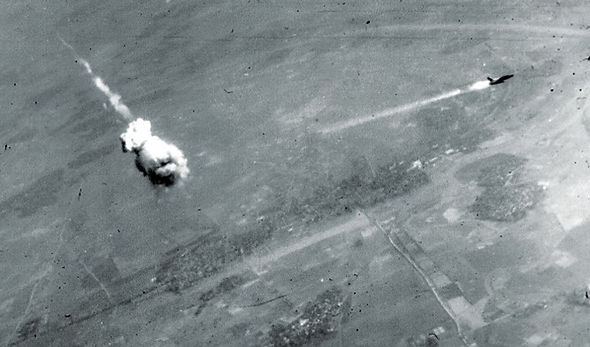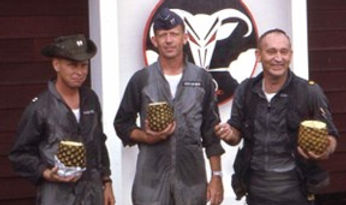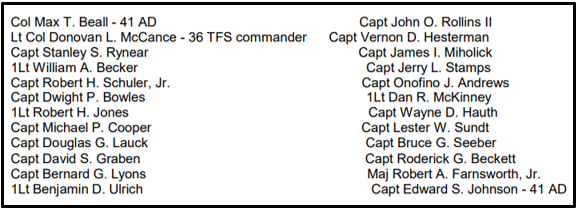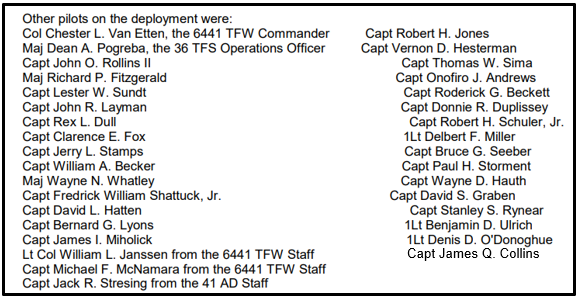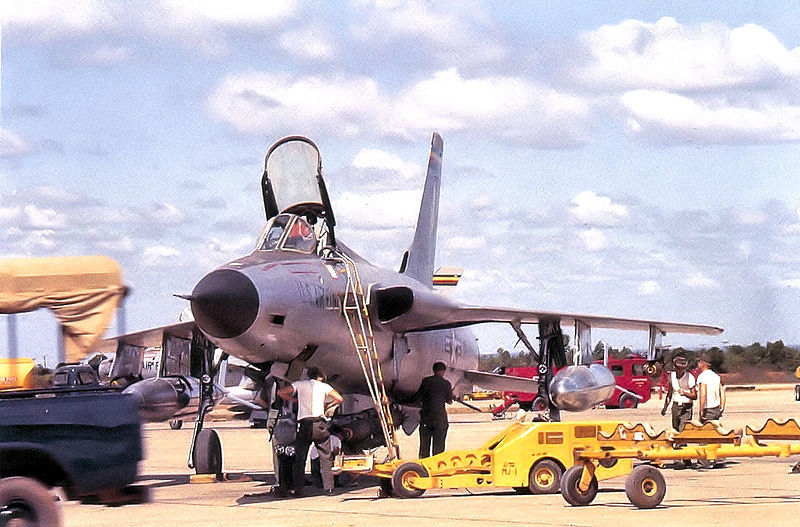
Fiends in Thailand
by Lt Col Caleb “BIFF” Cienski
Fiend Mayor, 2014-2015
The long and storied history of the Flying Fiends has often overlooked the squadron’s contributions to the Vietnam War. However, the stories of the 36th TFS during this era reveal the Fiends continued the excellence established in WWII and Korea while also demonstrating the devotion and squadron cohesion that continues today.
Sunday, 2 August 1964, was a normal day for the Flying Fiends at Yokota AB, Japan. The pilots were nursing hangovers, going to church, and putting up boards for their upgrade rides on Monday. One week later, F-105s from the 36th TFS were on their way to Korat RTAFB to answer the nation’s call. Long before they were part of the 51st Fighter Wing, the Fiends were ready to fight tonight. [1]
F-105s from the 36th TFS in front of Mt Fuji, 1964 [2]
US advisors had been in Vietnam since the early 1950s, but the Gulf of Tonkin incident on 2 August 1964 prompted the US to begin active combat operations against North Vietnam. While the exact conversation has been lost to history, the discussion about which combat units to deploy likely went something like this:
President Johnson[3] – I need your finest fighter jocks, Curtis. Not some namby-pamby air-to-air unit but real multi-role fighter pilots who can go kick these damn communists in their damn communist teeth!
Gen LeMay – I have just the boys, Mr President. I’ll send in the Flying Fiends from Yokota. [4]
President Johnson – Harrumph!
Gen LeMay – Harrumph!
Gen LeMay returned to the Pentagon, picked up the phone, and began barking orders. By 0200L on 8 August, those orders had trickled down to the commander of the 6441st TFW, Col C. L. Van Etten.
"I received a call on my hot line from General Graham, Fifth Air Force Commander in Tokyo. He wanted to know how long it would take to get 18 Thuds ready to deploy to Clark Air Base and then on to Korat RTAFB, Thailand. My answer was "tomorrow" - and that I could have 75 ready to fly to the Kremlin - all I needed was tankers. I selected Lt Col Don McCance, commander of the 36th to supply the birds and pilots." [5]
The Fiends packed their bags and Lt Col McCance led 12 pilots and 31 enlisted men into combat on a 179-day deployment to “Clark AFB, Philippines.”
Fiend 1, Lt Col McCance (Center) with 36th TFS pilots and mechanics. Itazuke AB, Japan, 1964
"We launched on schedule, refueled over Kadena Air Base on a KB-50J, with probe and drogue. Proceeded to Clark AB and flew through typhoon Ida enroute - the wildest ride of my life. We penetrated in elements of two at 26,000 ft and .88 Mach. All ended up at 12,000 ft and 1.01 Mach. One good thing about the Thud, it's built like a TANK."
"[We] arrived at Korat on 11 August and flew our first combat mission the following day - target in the Plaine Des Jarres - one bird damaged by flak. We continued deploying to Korat and Takhli until permanent squadrons were assigned to these bases." [6]
The Fiends flew the first F-105 combat sorties of the Vietnam War and sustained the first F-105 loss when the squadron had to scrap the aircraft damaged on 14 August. The early loss portended the fate of the “Thud” during the war. The USAF would lose 40% of its F-105 fleet in Vietnam, which was the highest loss rate of any aircraft of the war. [7]
The living conditions at Korat were so bad the USAF men called it “Camp Nasty.” But there was a mission to do and the 36th TFS flew combat sorties out of Korat – escorting CSAR aircraft and attacking anti-aircraft batteries – until 5 October 1964 when they were replaced by the Pantons.
36th TFS F-105 on the flightline at Korat. 1964[8]
Historians unanimously agree that the three lieutenants on that first deployment performed heroically and were an inspiration to the FGOs, who lauded their ability to be on frequency and in formation.
Capt Roderick Beckett, pilot with the initial 36th TFS deployment [9]
The Fiends spent the winter of 1964-65 sharpening their tactical flying skills, swapping stories at Shows, and building the brotherhood that would one day carry the Fiends north. By the spring of 1965, the Fiends were once again in the conversation. Again, the exact transcript no longer exists, but many eyewitnesses attested that the conversation was something like:
Gen McConnell [10] – So let me get this straight, Mr President, the plan is to gradually increase the pressure on Hanoi by slowly escalating our combat operations? And that is your plan to win this war?
President Johnson – Hell yes, McConnell? What like you’ve got a better idea?!
Gen McConnell - Well, sir…
President Johnson – Stay in your lane, McConnell! Who should we send to make sure this thing starts off the right way?
Gen McConnell – I have just the boys, Mr President. I’ll send in the Flying Fiends from Yokota.
President Johnson – Harrumph!
Gen McConnell – Harrumph!
The US launched Operation Rolling Thunder on 2 March 1965, and the Fiends returned to Thailand – this time to Takhli RTAFB – arriving on Saturday, 6 March 1965.[11]
Conditions at Takhli RTAFB were not much better than Korat. Pilots reported the “greatest problems encountered were in the areas of support and communication.”[12]
The Fiends participated in some of the earliest Rolling Thunder missions, initially interdicting roads, truck parks, and eventually bridges, including the infamous Thanh Hoa “Dragon’s Jaw” bridge. The Dragon’s Jaw was one of the heaviest-defended locations in North Vietnam and would claim dozens of aircraft and pilots throughout the war. The squadron would again swap with the 35th TFS and rotate back to Yokota in May.
North Vietnam raised the stakes on 4 April 1965 when the first SA-2 was reported in country. The SA-2 would claim its first victim in July of that year. The nascent SAM threat threatened US air operations and – to deal with the SAM threat – the US launched Operation Iron Hand on 12 August 1965.
The joint operation between the USAF and Navy was the first coordinated attempt to suppress and destroy SAMs. The name came from the nerves of steel required to attack a SAM site with only dumb bombs and cannon. The USAF needed more fighter pilots with such nerves of steel so – of course – the USAF tasked the Fabulous Flying Fiends back to Takhli RTAFB in late August 1965.[13] The squadron ops officer at the time was a fighter pilot named Dean “Pogie” Pogreba.
Dean Pogreba in front of his F-86 in Korea.
During the Korean war, then-Capt Pogreba had distinguished himself, earning a DFC for leading his 4-ship of F-86s against 24 MiG-15s, and spoiling their attack on friendly aircraft. Later in the war, during the attacks on Sui-ho dam – one of the largest raids of the Korean War – Capt Pogreba spotted a MiG-15 diving towards one of the fighter bombers in the strike package. Capt Pogreba set his lift vector low and in lead, led with the gun cross, and downed a MiG-15 with only two bursts of gunfire.[14]
On 22 August 1965, now-Major Pogreba had the unfortunate experience of having his F-105 cease to be airworthy in midair. While on an armed reconnaissance mission, “Pogie” punched out at 0705L about 25nm west of Thanh Hoa, Vietnam. The CSAR assets were airborne and quickly formed a rescue package, with Sandys from Udorn RTAFB escorting a CH-3C Jolly Green to find HUDSON 09, Pogreba’s callsign that day.
After spending just over 3.6 hours on the ground, the PJs lifted Maj Pogreba out of harm’s way. Many consider this the second Jolly Green rescue of the war.[15]
Pogreba (in the g-suit) with his rescue crew: Capt Phil Stambaugh, Capt George Martin, Sgt Francis Hill, Sgt James Armenia, and PJ Sgt George Thayer.
Pogie’s dedication to the mission was Fiend-standard and soon he was back in the cockpit. The following week Maj Pogreba became Fiend 1 as the commander of the 36th TFS.
He would lead the Fiends until October 1965. Col Jack Broughton[16] described him this way:
"Pogie was a guy you couldn’t overload. Since he was a major, we could and did make him everything from squadron commander to wing ops to squadron ops to flight leader to strike leader. Whenever there was a hole in the dike, we plugged Pogie in and he loved it…"
On 5 October 1965, the Fiends were fragged to go downtown; like way downtown; like target-in-Route-Pack-VI, north-of-Hanoi, near-the-Chinese-border downtown. Since the Fiends lead from the front, “Pogie” assumed the mission commander role for the strike. Capt. Bruce Seeber was leading another Fiend formation on the mission.
The target was a bridge in the Lang Son province. Despite the extreme difficulty of overcast cloud layers, haze, and rain showers, Major Pogreba flew at low level through mountain passes to the target area while encountering devastating automatic weapons and anti-aircraft artillery fire. With complete disregard for his personal safety, [he] climbed to 9,000 feet into over-hanging clouds, which made him highly vulnerable to the hostile ground fire, and delivered his ordnance directly on the target.[17]
An unidentified F-105 being hit by an SA-2.
Maj Pogreba emerged from the clouds and – though still subjected to intensive ground fire – assisted the other members of his flight in their weapons delivery, assuring complete destruction of this vital target.
Capt Seeber was next on target, and he led his flight on a high-speed, low-altitude ingress to the target. Finding his specific target obscured by weather, he selected a target of opportunity and popped into the overcast weather deck to position his element for an ideal run-in on the crucial intersection. After delivering his weapons, heavy ground fire crippled Capt Seeber’s Thud.[18]
Maj Pogreba called off target, but he never arrived at the rendezvous point off the coast, and other pilots could not establish radio contact with him. Other pilots flying the mission reported last seeing Maj Pogreba's aircraft rolling off target amid heavy anti-aircraft fire, and that at least three surface-to-air missiles detonated at the time.[19] Both Pogreba and Seeber were shot down on that mission.
Visual and electronic searches for Maj Pogreba were unsuccessful, and enemy presence in the area precluded any ground searches. Capt Seeber was captured and served honorably as a POW for the duration of the war until repatriation in 1973.[20]
The USAF listed Maj Dean Pogreba as missing in action and his remains were never found. He was posthumously promoted to the rank of Colonel.[21]
Lt Col Howard “Red Dog” Hendricks (above) [22] assumed command of the 36th TFS the following day. But there would be no pause in the pace of combat to mourn fallen comrades and the Fiends continued combat operations from Takhli.
The Iron Hand missions were some of the most dangerous combat sorties of the war. Especially in the pre-Wild Weasel era, there was no sophisticated technology to counter the SAM threat. An example of the Fiends’ superb performance on these missions came on 18 October 1965, when Capt Wayne Hauth was tasked to lead a 4-ship on an Iron Hand mission. Hauth was a longtime Flying Fiend and had been with the squadron on both deployments that year.
The target on that mission was a SAM and AAA site that protected an important industrial target.
Letting down through scattered cloud layers to mountain valleys in order to avoid radar detection, Captain Hauth weaved his way between mountain peaks. His efforts rewarded by achieving a high degree of surprise, he laid his bombs squarely into the target area.[23] Having accomplished his objective, Captain Hauth departed the area in the face of belatedly heavy anti-aircraft fire and with several hostile aircraft in trail but unable to close. Once over open sea, he expended his remaining ammunition in attacking and silencing several hostile armed junks which were in his path.
The USAF recognized Capt Hauth’s bravery on that mission by awarding him a Silver Star.
Hauth (left) with Fiend alumni “Rick” Layman (center) and “Dick” Fitzgerald (right) celebrate 100 missions in 1966 with the 34th TFS
The last known shootdown of a Fiend in combat occurred in mid-October, 1965 and remains an prime example of Fiend brotherhood. Capt Tom Sima was flying that day as OLDS 01. His wingman was Capt Robert Schuler. Their target was a barracks and storage area near Ha Tiang, North Vietnam, approximately 36nm from the Chinese border. OLDS flight launched out of Takhli at 0455L, refueled, and were soon in North Vietnam.
Approaching the target, Capt Sima found a hole in the undercast and brought his flight down to the target, breaking out around 7,000’ MSL. He visually acquired the target and rolled in. He ended up on a bad wire, and – unwilling to waste his bombs, or miss the target – called off, dry. In his climb, around
twenty 37mm and 57mm AAA sites opened fire. His Thud was hit and he ejected around 0625L.
OLDS 03 – Capt Onofiro Andrews – directed Capt Schuler to assume the on-scene commander role while OLDS 03 and 04 departed for the tanker and began coordinating for rescue forces. Despite multiple threats in the area – both the deadly AAA and nearby SAMs - Schuler orbited overhead, dodging weather and attempting to raise OLDS 01 on the SAR frequency.
When the other element returned from the tanker, OLDS 02 was missing. Capt Andrews attempted contact until bingo fuel but was unable to raise Schuler on the radio.
Due to the remote location and worsening weather, rescue efforts proved unsuccessful and were cancelled after two days. Capt Sima was captured and was a POW until Operation Homecoming in 1973. Capt Schuler was listed as Missing in Action.
Their last deployment proved the deadliest of the war, with the Fiends losing at least nine Thuds and five pilots in combat. The squadron would not return to Thailand during the Vietnam War.
When the 36th TFS returned to Yokota, the USAF reassigned most of the pilots and aircraft from the squadron to stand-up the 34th TFS at Korat RTAFB. The experience and tactical prowess of the 36th TFS would impact the war for years to come as Fiend alumni continued flying combat sorties with new squadrons.
For over a century – since their founding at Kelly Field in 1917 – the Fabulous Flying Fiends have been “The First Team.” They were the first F-105 unit to fly combat in the Vietnam war and the first to lose an F-105. Their dedication was evident in their resolve to continue flying dangerous combat sorties – both Iron Hand missions and repeated attacks on the Thanh Hoa bridge – in some of the most difficult situations imaginable. The Fiends built a brotherhood that took them north and they were willing – if necessary – to stick together, even if it cost them their lives. The performance of the 36th Tactical Fighter Squadron during the Vietnam War continued the excellence forged by the squadron in WWII and Korea; the same excellence which marks the Fiends today.
36th TFS aircraft losses during Vietnam
F-105D 62–4371
9/14/1964: Written off from battle damage over Laos, at Korat RTAFB, Thailand. (Graben)
F-105D 62-4235
8/22/1965: Shot down by ground fire near Thanh Hoa, North Vietnam. (Pogreba)[24]
F-105D 62-4351
8/23/1965: Crashed near Thanh Hoa, North Vietnam.
F-105D 62-4355
8/30/1965: Destroyed in a take-off accident at Takhli RTAFB, Thailand. (Hendricks)
F-105D 62-4389
9/2/1965: Shot down by ground fire near Yen Chau/Xung Lung, North Vietnam. (Collins)[25]
F-105D-31-RE 62-4295
10/5/1965: Shot down by ground fire near Bac Giang, North Vietnam. (Pogreba)
F-105D 62-4376
10/5/1965: Shot down by ground fire near the Long Met Bridge/Bac Giang, North Vietnam. (Seeber)
F-105D 62-4305
10/14/1965: Shot down by a MiG-17 near Moc Chau, North Vietnam. (Schuler)
F-105D 62-4333
10/14/1965: Shot down by ground fire near Moc Chau, North Vietnam. (Sima)
F-105D 62-4350
10/22/1965: Shot down by ground fire near Kep/Haiphong, North Vietnam. (Cherry)[26]
36th TFS Roster – Korat RTAFB – 9 August – 5 October 1964
36th TFS Roster – Takhli RTAFB – 6 March to 4 May 1965
36th TFS Roster – Takhli RTAFB – 26 August to 28 October 1965
Notes
[1] Or at least, “Ready to fight this week.”
[2] The Thud in the background, Tail 62-4355, would be destroyed on takeoff when a mechanical failure prevented “Red Dog” Hendricks from rotating. He ran off the end of the runway at Takhli but survived.
[3] LBJ was the 36th president of the United States. Coincidence? Do your own research!
[4] The other options from the 6441st TFW were the 80th TFS and the 35th TFS. Presumably Gen LeMay knew about the social liabilities of the Juvats and was worried about the ability of Korat RTAFB to remain operational with the Pantons and their penchant for taking the cable unnecessarily.
[5] Memoirs of Col Van Etten.
[6] Memoirs of Col Van Etten.
[7] The Crucible of Vietnam, Rebecca Grant, Air Force Magazine, Feb 2013.
[8] Note the unpainted Cold War metallic scheme on the F-105, not the SEA camo the USAF would adopt later.
[9] Prime example of how badass fighter pilots were during this era, especially in the Fiends.
[10] USAF Chief of Staff from 1 Feb 65 to 31 Jul 69.
[11] Otherwise displayed as 3/6/65 – Harrumph!
[12] It is comforting to know fighter pilots no longer need to worry about support and COMM.
[13] The Wild Weasels would not arrive until later that year. Even so, other fighter pilots griped that the Fiends were suppressing enemy air defenses, despite not flying Block 50 F-16s.
[14] Excerpts from Pogreba’s DFC citation. Among the fighter-bomber units involved in the raid on 24 Jun 53 were the 36th FBS and the 182nd FBS of the Texas Air National Guard.
[15] The CH-3C from this rescue mission was painted all black – the only one of its kind – and earned the name “Black Mariah.” This helicopter is now on display at the National Museum of the Air Force in Ohio.
[16] At the time, the Deputy Commander for Ops in the 4661st TFW. Broughton later wrote “Thud Ridge” which is an all-time great fighter pilot memoir.
[17] Fiends don’t miss! Excerpts from Maj Pogreba’s Air Force Cross citation.
[18] Again… Fiends don’t miss! Excerpts from Capt Seeber’s Silver Star citation.
[19] Excerpts from Maj Pogreba’s Air Force Cross citation.
[20] Capt Seeber received a Silver Star for his gallantry on that mission.
[21] Three Forks Airport in Montana is known as Pogreba Field, after the Montana native.
[22] Photo taken while “Red Dog” was the 34th TFS Commander in 1966.
[23] Example #3 – Fiends don’t miss! Excerpts from Capt Hauth’s Silver Star citation.
[24] Conflicting reports on which aircraft Pogreba ejected from in August 1965, some reports say 62-4351.
[25] Capt Collins had recently graduated from USAF Fighter Weapons School in August, 1965 and was TDY with the 36th TFS as the Wing Weapons Officer at Takhli RTAFB. He was a POW until 1973.
[26] Maj Fred Cherry was with the 35th TFS but flying a Fiend Thud when he was shot down on an Iron Hand mission and captured. He served honorably as the highest-ranking black officer among the American POWs.
